Scientific name Aconitum | Tribe Delphinieae Higher classification Delphinieae | |
 | ||
Lower classifications Aconitum napellus, Aconitum carmichaelii, Wolfsbane, Aconitum anthora, Aconitum variegatum | ||
Poisonous plants 1 2 1 aconitum napellus monkshood
Aconitum (/ˌækəˈnaɪtəm/), also known as aconite, monkshood, wolf's bane, leopard's bane, mousebane, women's bane, devil's helmet, Queen of all Poisons, or blue rocket, is a genus of over 250 species of flowering plants belonging to the family Ranunculaceae. These herbaceous perennial plants are chiefly native to the mountainous parts of the Northern Hemisphere, growing in the moisture-retentive but well-draining soils of mountain meadows. Most species are extremely poisonous and must be dealt with carefully.
Contents
- Poisonous plants 1 2 1 aconitum napellus monkshood
- Aconitum napellus monkshood a poisonous beauty
- Description
- Ecology
- Uses
- Cultivation
- Toxicology
- Medicinal use
- Etymology
- As a poison
- Wolfs bane
- In mysticism
- Taxonomy
- Natural hybrids
- References

Aconitum napellus monkshood a poisonous beauty
Description
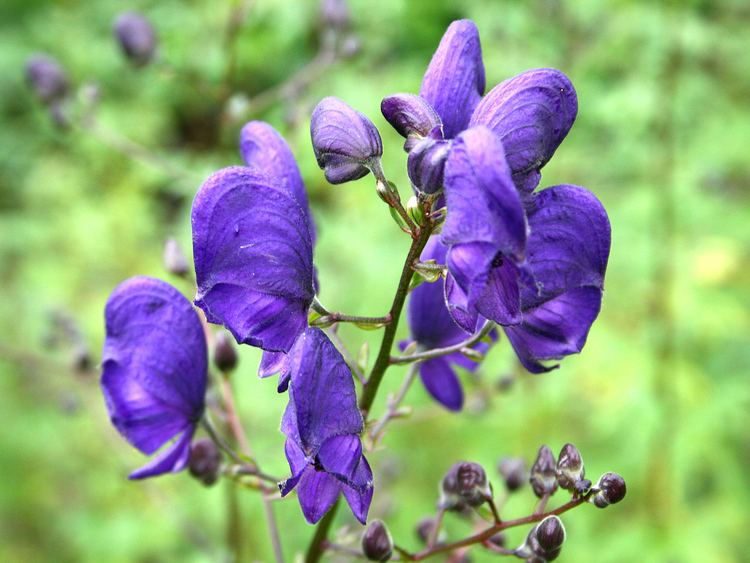
The dark green leaves of Aconitum species lack stipules. They are palmate or deeply palmately lobed with 5–7 segments. Each segment again is 3-lobed with coarse sharp teeth. The leaves have a spiral (alternate) arrangement. The lower leaves have long petioles.
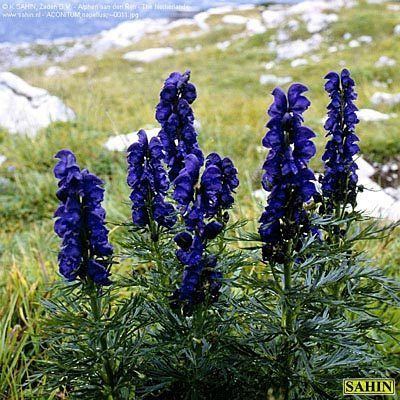
The tall, erect stem is crowned by racemes of large blue, purple, white, yellow or pink zygomorphic flowers with numerous stamens. They are distinguishable by having one of the five petaloid sepals (the posterior one), called the galea, in the form of a cylindrical helmet; hence the English name monkshood. There are 2–10 petals. The two upper petals are large and are placed under the hood of the calyx and are supported on long stalks. They have a hollow spur at their apex, containing the nectar. The other petals are small and scale-like or non-forming. The 3–5 carpels are partially fused at the base.
The fruit is an aggregate of follicles, a follicle being a dry many-seeded structure.
Ecology
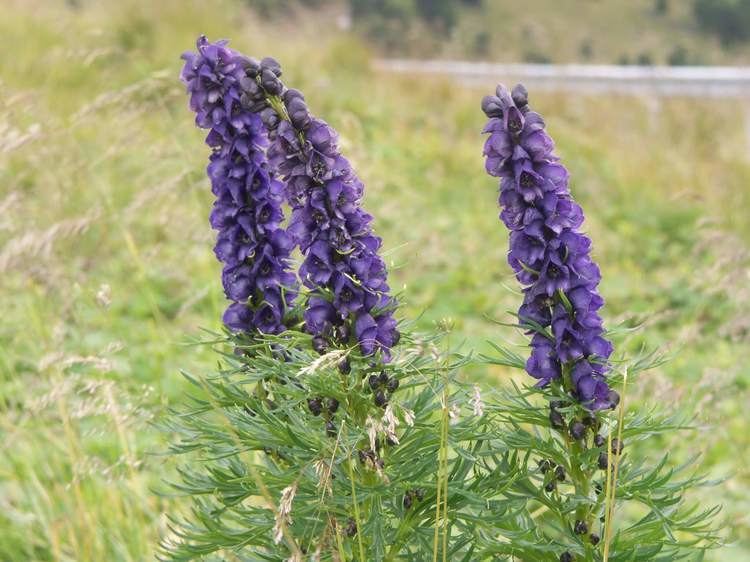
Aconitum species have been recorded as food plant of the caterpillars of several moths. The Yellow Tiger Moth Arctia flavia, and the Purple-shaded Gem Euchalcia variabilis are at home on A. vulparia. The Engrailed Ectropis crepuscularia, Yellow-tail Euproctis similis, Mouse Moth Amphipyra tragopoginis, Pease Blossom Periphanes delphinii, and Mniotype bathensis, have been observed feeding on A. napellus. The Purple-lined Sallow Pyrrhia exprimens, and Blepharita amica were found eating from A. septentrionale. The Dot Moth Melanchra persicariae occurs both on A. septentrionale and A. intermedium. The Golden Plusia Polychrysia moneta is hosted by A. vulparia, A. napellus, A. septentrionale and A. intermedium. Other moths associated with Aconitum species include the Wormwood Pug Eupithecia absinthiata, Satyr Pug E. satyrata, Aterpia charpentierana and A. corticana. It is also the primary food source for the Old World bumblebee Bombus consobrinus.
Uses
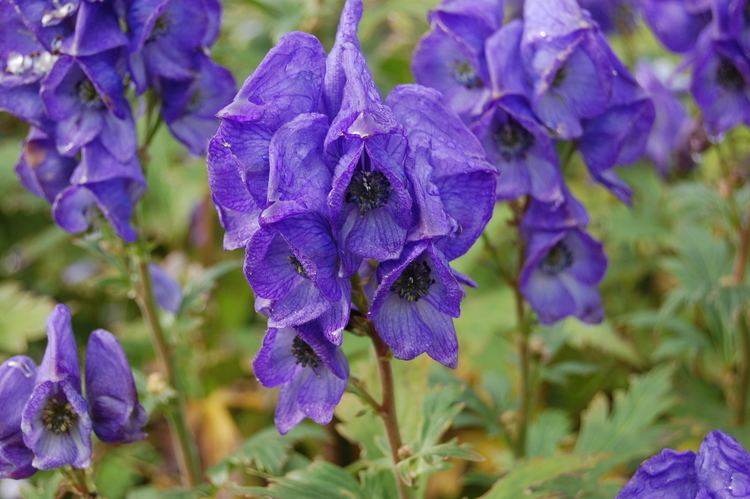
The roots of Aconitum ferox supply the Nepalese poison called bikh, bish, or nabee. It contains large quantities of the alkaloid pseudaconitine, which is a deadly poison. Aconitum palmatum yields another of the bikh poisons. The root of Aconitum luridum, of the Himalaya, is said to be as poisonous as that of A. ferox or A. napellus.

Several species of Aconitum have been used as arrow poisons. The Minaro in Ladakh use A. napellus on their arrows to hunt ibex, while the Ainu in Japan used a species of Aconitum to hunt bear. The Chinese also used Aconitum poisons both for hunting and for warfare. Aconitum poisons were used by the Aleuts of Alaska's Aleutian Islands for hunting whales. Usually, one man in a kayak armed with a poison-tipped lance would hunt the whale, paralyzing it with the poison and causing it to drown.
Cultivation

Several species of Aconitum are cultivated in gardens, having either blue or yellow flowers. They thrive in garden soils, and will grow in the shade of trees. They are easily propagated by divisions of the root or by seeds; care should be taken not to leave pieces of the root where livestock might be poisoned. The hybrid cultivar A. × cammarum 'Bicolor' has gained the Royal Horticultural Society's Award of Garden Merit.
Toxicology

Marked symptoms may appear almost immediately, usually not later than one hour, and "with large doses death is almost instantaneous." Death usually occurs within two to six hours in fatal poisoning (20 to 40 mL of tincture may prove fatal). The initial signs are gastrointestinal including nausea, vomiting, and diarrhea. This is followed by a sensation of burning, tingling, and numbness in the mouth and face, and of burning in the abdomen. In severe poisonings pronounced motor weakness occurs and cutaneous sensations of tingling and numbness spread to the limbs. Cardiovascular features include hypotension, sinus bradycardia, and ventricular arrhythmias. Other features may include sweating, dizziness, difficulty in breathing, headache, and confusion. The main causes of death are ventricular arrhythmias and asystole, paralysis of the heart or of the respiratory center. The only post-mortem signs are those of asphyxia.

Treatment of poisoning is mainly supportive. All patients require close monitoring of blood pressure and cardiac rhythm. Gastrointestinal decontamination with activated charcoal can be used if given within one hour of ingestion. The major physiological antidote is atropine, which is used to treat bradycardia. Other drugs used for ventricular arrhythmia include lidocaine, amiodarone, bretylium, flecainide, procainamide, and mexiletine. Cardiopulmonary bypass is used if symptoms are refractory to treatment with these drugs. Successful use of charcoal hemoperfusion has been claimed in patients with severe aconitine poisoning.
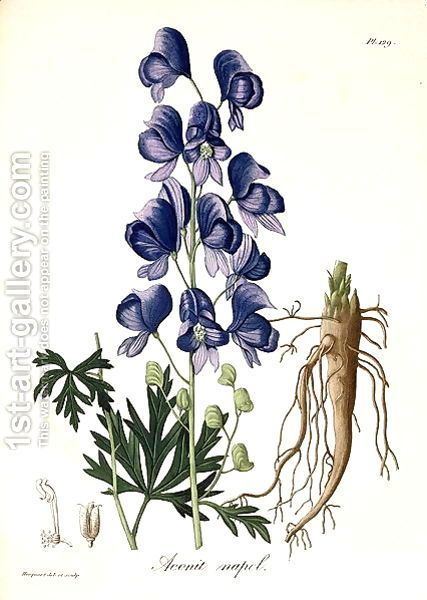
Poisoning may also occur following picking the leaves without wearing gloves; the aconitine toxin is absorbed easily through the skin. In this event, there will be no gastrointestinal effects. Tingling will start at the point of absorption and extend up the arm to the shoulder, after which the heart will start to be affected. The tingling will be followed by unpleasant numbness. Treatment is similar to poisoning caused by oral ingestion.
Aconitine is a potent neurotoxin that opens tetrodotoxin sensitive sodium channels. It increases influx of sodium through these channels and delays repolarization, thus increasing excitability and promoting ventricular dysrhythmias.
Canadian actor Andre Noble died during a camping trip on July 30, 2004, after the accidental consumption of aconite from monkshood.
In January 2009 the British 'Curry Killer' Lakhvir Singh, killed her lover Lakhvinder Cheema with a curry dish laced with Indian Aconite. On 11 February 2010 she was sentenced to life imprisonment with a minimum term of 23 years for the murder.
Nathan Greenway, a gardener at Mill Court House in Hampshire, England, died of multiple organ failure on 7 September 2014. At the inquest following his death, it was speculated that his fatal condition may have been caused by him brushing against the plant, although an open verdict was recorded. When he was first taken to hospital, doctors thought he was suffering from ebola.
Medicinal use
Aconite has long been used in traditional Chinese medicine and Ayurveda (Hindu traditional medicine). Aconite was also described in Greek and Roman medicine by Theophrastus, Dioscorides, and Pliny the Elder, who most likely prescribed the Alpine species Aconitum lycoctonum.
Etymology
The name aconitum comes from the Greek ἀκόνιτον, which may derive from the Greek akon for dart or javelin, the tips of which were poisoned with the substance, or from akonae, because of the rocky ground on which the plant was thought to grow. The Greek name lycotonum, which translates literally to wolf's bane, is thought to indicate the use of its juice to poison arrows or baits used to kill wolves.
As a poison
Aconite has been understood as a poison from ancient times, and is frequently represented as such in fiction. In Greek mythology, the goddess Hecate is said to have invented aconite, which Athena used to transform Arachne into a spider. Also, Medea attempted to poison Theseus with a cup of wine poisoned with wolfsbane. The kyōgen (traditional Japanese comedy) play Busu (附子, "Dried aconite root"), which is well-known and frequently taught in Japan, is centered around dried aconite root used for traditional Chinese medicine. Taken from Shasekishu, a thirteenth-century anthology collected by Muju, the story describes servants who decide that the dried aconite root is really sugar, and suffer unpleasant though non-lethal symptoms after eating it. Shakespeare, in Henry IV Part II Act 4 Scene 4 refers to aconite, alongside rash gunpowder, working as strongly as the "venom of suggestion" to break up close relationships.
As a well-known poison from ancient times, aconite is well-suited for historical fiction. It is the poison used by a murderer in the third of the Cadfael Chronicles, Monk's Hood by Ellis Peters, published in 1980 and set in 1138 in Shrewsbury. In I, Claudius, Livia, wife of Augustus, was portrayed discussing the merits, antidotes and use of aconite with a poisoner. It also makes a showing in alternate history novels and historical fantasy, such as S. M. Stirling's, "On the Oceans of Eternity", where a renegade warlord is poisoned with aconite laced food by his own chief of internal security, and in the television show Merlin the lead character Merlin, attempts to poison Arthur with aconite while under a spell. In the 2003 Korean television series Dae Jang Geum, set in the 15th-16th century, Choi put wolfsbane in the previous Queen's food.
Aconite also lends itself to use as a fictional poison in modern settings. An overdose of aconite was the method in which Rudolph Bloom, father of Leopold Bloom in James Joyce's Ulysses, committed suicide. In the television series Midsomer Murders, season 4, episode 1 ("Garden of Death"), aconite is used as a murder weapon, mixed into fettucine with pesto to mask the taste. In the Australian detective series Miss Fisher's Murder Mysteries, series 1, episode 5 ("Raisins and Almonds"), the ground root of wolfsbane is used as a murder weapon. In Rizzoli and Isles Season 1 Episode 3 "Sympathy For The Devil" Maura Isles discovered a teenage boy named Matisse killed by monkshood mixed into a water bottle. In the 2014 season of NCIS:L., assistant director, Owen Granger, and members of his staff are poisoned with "monkshood" by a mole within the agency. In the TV series Dexter (Season 7), the character Hannah McKay uses aconite to poison some of her victims.
In Episode 9 of the TV Series American Horror Story: Coven, the resurrected Myrtle Snow poisons former fellow Witches council members with monkshood laced melonballs. This was portrayed as paralyzing them while she gouges out their eyes (one from each) with a melon baller.
In the manga and anime series, Katekyo Hitman Reborn, one of the main antagonists, Torikabuto, is named after the more specific Japanese name (トリカブト) for this plant.
Wolf's bane
In Metamorphoses, Ovid tells how the herb comes from the slavering mouth of Cerberus, the three-headed dog that guarded the gates of Hell. As the veterinary historian John Blaisdell has noted, symptoms of aconite poisoning in humans bear some passing similarity to those of rabies: frothy saliva, impaired vision, vertigo, and finally a coma. Thus, it is possible that some ancient Greeks would have believed that this poison, mythically born of Cerberus's lips, was literally the same as that to be found inside the mouth of a rabid dog.
In mysticism
Taxonomy
Genetic analysis suggests that Aconitum as it was delineated before the 21st century is nested within Delphinium sensu lato, that also includes Aconitella, Consolida, Delphinium staphisagria, D. requini and D. pictum. Further genetic analysis has shown that the only species of the subgenus "Aconitum (Gymnaconitum)", "A. gymnandrum", is sister to the group that consists of Delphinium (Delphinium), Delphinium (Delphinastrum), and "Consolida" plus "Aconitella". In order to make Aconitum monophyletic, "A. gymnandrum" has now been reassigned to a new genus, Gymnaconitum. In order to make Delphinium monophyletic, the new genus Staphisagria was erected containing S. staphisagria, S. requini and S. pictum.
